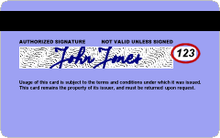

A card security code (CSC; also known as CVC, CVV, or several other names) is a series of numbers that, in addition to the bank card number, is printed (but not embossed) on a credit or debit card. The CSC is used as a security feature for card not present transactions, where a personal identification number (PIN) cannot be manually entered by the cardholder (as they would during point-of-sale or card present transactions). It was instituted to reduce the incidence of credit card fraud. Unlike the card number, the CSC is deliberately not embossed, so that it is not read when using a mechanical credit card imprinter which will only pick up embossed numbers.
These codes are in slightly different places for different card issuers. The CSC for Visa, Mastercard, and Discover credit cards is a three-digit number on the back of the card, to the right of the signature box. The CSC for American Express is a four-digit code on the front of the card above the account number. See the figures to the right for examples.
CSC was originally developed in the UK as an eleven-character alphanumeric code by Equifax employee Michael Stone in 1995. After testing with the Littlewoods Home Shopping group and NatWest bank, the concept was adopted by the UK Association for Payment Clearing Services (APACS) and streamlined to the three-digit code known today. Mastercard started issuing CVC2 numbers in 1997 and Visa in the United States issued them by 2001. American Express started to use the CSC in 1999, in response to growing Internet transactions and card member complaints of spending interruptions when the security of a card has been brought into question.
Contactless card and chip cards may electronically generate their own code, such as iCVV or a dynamic CVV.366